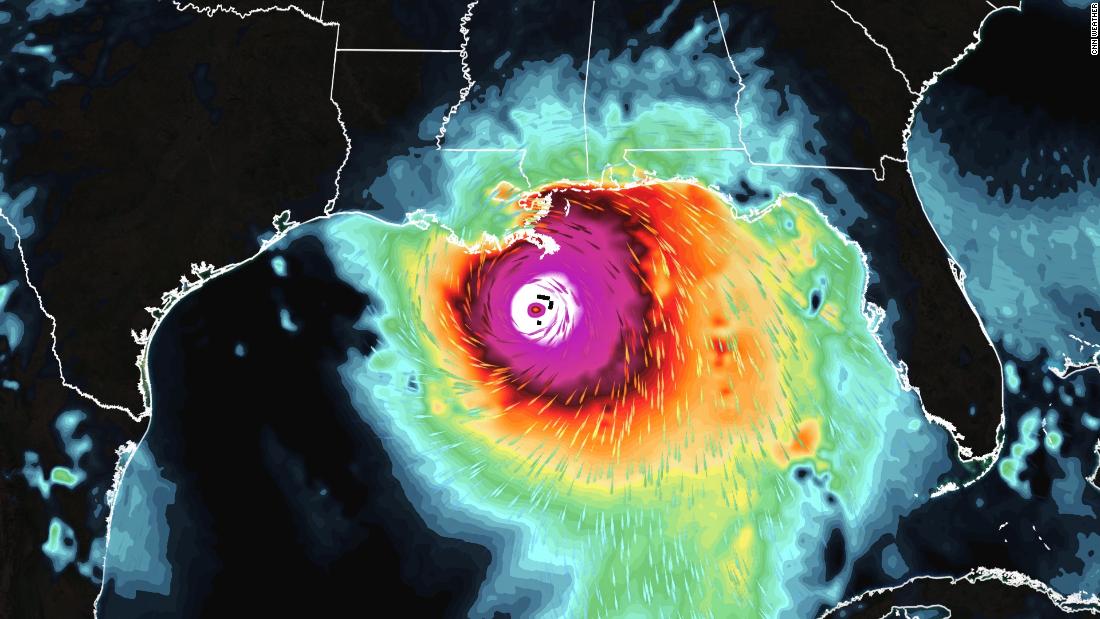What it means for a hurricane to ‘rapidly intensify’
Are you affected by Hurricane Ida? Text, iMessage or WhatsApp your videos, photos and stories to CNN at +1 347-322-0415
“Rapid strengthening is forecast during the next 24 to 36 hours and Ida is expected to be an extremely dangerous major hurricane when it approaches the northern Gulf Coast on Sunday,” the NHC said.
The updated forecast track from the hurricane center has the storm still strengthening into a Category 4 hurricane by Sunday, then making landfall on the central Louisiana coast with sustained winds of at least 130 mph.
Ida already rapidly intensified Friday prior to landfall and as it made landfall on Cuba — gaining 40 mph in wind speed, from 40 mph Thursday night to 80 mph Friday night.
Katrina increased by 57 mph in an astonishing 18 hours. Rita increased by a whopping 69 mph in its first 24 hours in the Gulf of Mexico.
Perfect conditions are needed
While there isn’t much definitive data on rapid intensification, a few key atmospheric ingredients help it happen, CNN meteorologist Michael Guy said. They’re the same conditions that often emerge in the Atlantic basin between August and October.
Ocean water needs to be warm — more than 86 degrees Fahrenheit is ideal — with that heat extending beneath the surface. Upper level winds must be calm so they don’t disrupt thunderstorm activity.
A storm’s internal conditions also must be just right. A hurricane needs a way to ventilate, much like a car engine, so it can continue to process all of the fuel from the warm water and use it to strengthen the storm.
Rapid intensification is rare
Because all those pieces must be in place, rapid intensification is rare, with just one or two Atlantic storms per year undergoing such an acceleration.
In 2015, Hurricane Patricia, one of the strongest storms ever recorded, went through one of the fastest and most drastic rapid intensification cycles, with winds increasing about 120 mph in 24 hours.
These storms are more dangerous
But it’s notoriously hard to predict rapid intensification because forecast models fail to pick up on all the different variables that feed into it — and because rapid intensification doesn’t always happen when the variables are present.
For instance, forecast models did not predict the rapid intensification in 2017 that made Hurricane Harvey a Category 4 storm in such a short period before it hit the Texas coast.
Storms are rapidly intensifying more frequently
In rapid intensification, warmer waters must extend beyond just the surface, going hundreds of feet deep to allow plenty of heat content for hurricanes to use for fuel.
“If you increase the speed limit, you make more room for the storms to strengthen, so it can intensify more quickly,” according to Jim Kossin, an atmospheric research scientist at NOAA’s National Centers for Environmental Information.
This has led scientists to believe that storms are more likely to undergo “rapid intensification” as a result of climate change warming the oceans.
Some recent research has shown this increase observed in global tropical data, but the confidence in the data is low.
“We used to observe storms less frequently and with satellites that had lower resolution, and consequently, we likely couldn’t measure rapid intensification as well as we can now,“ Phil Klotzbach, a research scientist at Colorado State University, told CNN.
![]()


